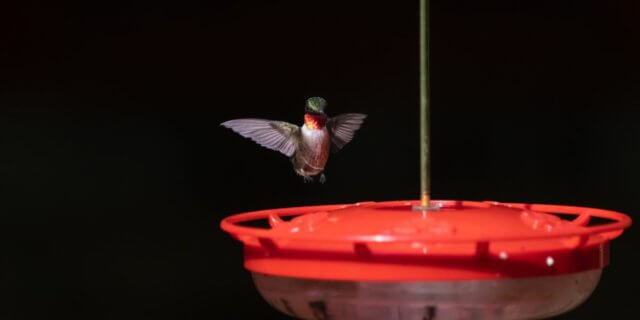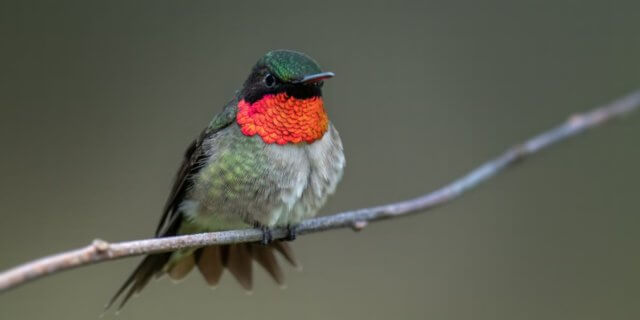
It’s Hummingbird Week. What—never heard of it? Well, that’s probably because we just made it up.
Yep, turns out we’re big hummingbird people. We’ve been closely following along with this nifty Hummingbird Central map, where we’re tracking the early arrivals of the first hummingbirds to Iowa. And with a camera in one hand and gardening glove on the other, we vow to be ready when one of the tiny birds comes humming into our backyard.
To prepare for their annual migration from warmer climates—like Mexico, Central America, and South America—to Iowa to mate, nest, and raise their young, we gathered information and answered your top questions about hummingbirds.
When can I expect to see hummingbirds in Iowa?
The time is now. Hummingbirds migrating to Iowa start to trickle in from mid- to late April. Male ruby-throated hummingbirds migrate about two weeks before the females.
In late summer, they’ll migrate back south to areas like The Gulf of Mexico, Central America, and South America.
Here’s a tip—keep your feeder up for any procrastinators, because there will be some. Hummingbirds typically stick around Iowa until August or September. Some stragglers will even stay behind until early October if warmer temperatures persist.
Why do hummingbirds come to Iowa?
This is a natural migration for hummingbirds as they come northward to choose a mate, nest, and raise their chicks. Hummingbirds typically settle into one nest each migration.
Northern summers provide a hospitable habitat, where food is plentiful and there’s less competition. It’s a win-win.
What type or types of hummingbirds do we see in Iowa?
In Iowa, we mainly see only the ruby-throated hummingbird.
Ruby-throated hummingbirds are sexually dimorphic—meaning that the males and females have different appearances. Males are the ones with the ruby throat. Females have a white throat. Both have a slick dark green coat of feathers. Colors on ruby-throated hummingbirds are iridescent—meaning they reflect light. While feathers can appear to be darker at first, when seen in good light, they’ll glow.
But while the ruby-throated hummingbird is the main species you’ll find in Iowa, they’re not the only one. The rufous hummingbird looks quite different from ruby-throated hummingbirds—males have a primarily copper-orange color on their backs and an iridescent throat, while females may have some orange coloring but are primarily white with a green crown. Spotting a rufous hummingbird in Iowa is extremely rare. Fewer than 0.01% cases of these sightings have been reported in the state.
Other western hummingbird species may get lost and linger in Iowa, too, especially in the fall. These may include the Broad-billed hummingbird and Mexican violetear.
To see hummingbird species hotspots, check out eBird. Their map function can help you know where to look.
For more information about hummingbirds, visit this Iowa Department of Natural Resources guide. Want to see a map of their migration? Check it out here.

How can I best see hummingbirds?
Hummingbirds are very fast and very small, so they can be hard to spot. But there may be more hummingbirds around than you realize.
As much as you’re keeping an eye out, keep an ear out, too. An odd buzz you hear in the air could be from the fast-paced fluttering of hummingbird wings—they flap 200 times per second. And their vocalizations take the form of a high-pitch twittering sound.
If you think you’re missing them because your yard is simply inhospitable to hummingbirds, think again. As long as there’s foliage and flowers (and hummingbird feeders) they’ll stick around until September.
If you’re interested in hosting hummingbirds, follow these simple do’s and don’ts.
Do’s and Don’ts of Hosting Hummingbirds
DO plant native flowers, trees, and everything in-between. This is the single-best way you can support hummingbirds, ecologists say. Hummingbirds come here with a specific type of food in mind—and they developed that taste long before we carved out cities, manicured lawns, and farmland.
Like bees, hummingbirds play an important role as pollinators, so if you grow native plants, you’ll be supporting a habitat that pre-dates any of us—and a vibrant, colorful, healthy Iowa ecosystem that we all benefit from.
- Examples of native plants: Beebalm, Lobelia, Cardinal flower, and Eastern columbine to start. To find more, use this Audubon native plant searcher. It’s as easy as entering your zip code.
- Think of it this way: Hummingbird feeders give hummingbirds a reason to stop by your garden. Native plants give them a reason to hang around, and to come back tomorrow.
DO put out hummingbird feeders. Hummingbirds will thank you for the treat!
Of course, hummingbirds love nectar—and instead of spending money at a store for a mix that might not be as high quality, you can make nectar at home. It’s just one part sugar for four parts of hot water, and then stir till the mixture is consistent—yes, it’s that easy.
- DO NOT put out hummingbird food or nectar with artificial ingredients or red food dye. Try a red feeder instead.
- DO NOT use honey or any artificial sweeteners.
DO clean out your feeders at least once a week. This goes for any bird feeder. If you don’t clean out feeders, food sources can ferment or cake up, making them less appealing—or even harmful—to visitors.
- To clean your feeders, simply use one part white vinegar to four parts water, and dry out.
DO leave out clean water as well. Hey, hummingbirds could use a drink after a long day of pollinating. Bird baths—especially shallow bird baths—are great for hummingbirds. Naturally flowing sources of water are even better, if you happen to live by one.
DO NOT use any pesticides or chemicals. These are dangerous to hummingbirds and all animals. Hummingbirds feed on bugs as well as nectar, so a natural yard is also more likely to attract hummingbirds.
DO NOT take down your hummingbird feeders too soon. Even though high time for hummingbirds is in the summer, don’t assume that all have made their way out of Iowa by the early fall. While most start returning south in August or September, the occasional odd bird might stay around until the weather cools even further, for whatever reason. Especially for those leaving later in the year, food can be in short supply, and feeders will be a great resource to them.

Are hummingbirds really birds?
They are definitely just tiny birds, not insects. But there is fair reason for wondering—hummingbirds’ use and functionality of their wings more closely resembles that of insects.
If you watch a slo-mo video of a hummingbird, you’ll notice its wings can move with a dexterity that other birds don’t have. That’s why hummingbirds can even fly backward!
The smallest bird in the world is also a hummingbird, and it’s funnily enough named “the bee hummingbird.”
What else should I know about hummingbirds?
Well, there are more than 300 species of hummingbirds, but they’re only found in the western hemisphere.
And ruby-throated hummingbirds—the ones that nest in Iowa—have their own claim to fame: According to the Guinness Book of World Records, ruby-throated hummingbirds can flap their wings 200 times in a second, the fastest pace of any species of bird—hummingbird or not.
Written by Isaac Constans for Iowa Starting Line

2 Comments on "It’s Hummingbird Season in Iowa! Here’s What to Know"
Very nice story! Thank you!
The only small thing I would add is that it is even more important to clean hummingbird feeders often when it becomes hotter outside. Hot weather speeds up the rate at which sugar water deteriorates.
Hi all, I had always been taught to take the feeders down by the end of September. The reason being that the young birds may not want to go see South if they have a food source. If this is true the young birds may hit cold weather before making it to a warmer climate.